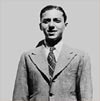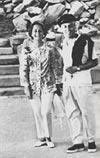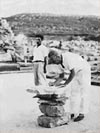Biographical Note

Constantinos A. Doxiadis, the son of Apostolos and Evanthia (Mezeviri) Doxiadis, was born in 1913. His father, a pediatrician, was Minister of Refugees, Social Welfare and Public Health and organized many welfare services, especially for children. He graduated as Architect-Engineer from the Athens Technical University in 1935 and obtained his doctorate at Charlottenburg University, Berlin, one year later.
In 1937 he was appointed Chief Town Planning Officer for the Greater Athens Area and during the war (1940-1945) held the post of Head of the Department of Regional and Town Planning in the Ministry of Public Works while also serving as a corporal in the Greek Army. During the Occupation he was Chief of the National Resistance Group, Hephaestus, and published a magazine called "Regional Planning, Town Planning, Architecture", the only underground technical publication anywhere in occupied territories. At the time of Greece's liberation in 1945 he left the army with the rank of captain, and went to the San Francisco Peace Conference as a member of the Greek delegation. In 1945 he also served as Greece's representative to England, France and the United States on the problems of postwar reconstruction.

From 1945 to 1951 Doxiadis was one of the prime leaders in restoring Greece to a normal peacetime existence, first as Undersecretary and Director-General of the Ministry of Housing and Reconstruction (1945-48), and subsequently as Minister-Coordinator of the Greek Recovery Program and Undersecretary of the Ministry of Coordination (1948-51). During these years he was also head of the Greek Delegation at the UN International Conference on Housing, Planning and Reconstruction (1947) and head of the Greek Delegation at the Greco-Italian War Reparations Conference (1949-50).
In 1953 he founded Doxiadis Associates, a private firm of consulting engineers, with a small group of architects and planners, many of whom had worked with him on the Greek Recovery Program. The company grew rapidly until it had offices on five continents and projects in 40 countries, acquiring its legal form as DA International Co., Ltd., Consultants on Development and Ekistics, in 1963. In 1958 Doxiadis founded the Athens Technological Organization and in 1963 the Athens Center of Ekistics. From 1958 to 1971 he taught ekistics at the Athens Technological Organization and lectured at universities all over the United States as well as at Oxford and Dublin.

In 1963 and 1964 he served as representative of Greece on the Housing, Building and Planning Committee of the Economic and Social Council of the United Nations in New York and was chairman of the Session on Urban Problems at the UN Conference on the Application of Science and Technology for the benefit of the less developed areas held in Geneva in 1963.
During his lifetime Doxiadis received several awards and decorations, both civil and military as well as one posthumous award, the Royal Architectural Institute of Canada's Gold Medal for 1976.
His awards and decorations are as follows: Greek Military Cross, for his services during the war 1940-41 (1941); Order of the British Empire, for his activities in the National Resistance and for his collaboration with the Allied Forces, Middle East (1945); Order of the Cedar of Lebanon, for his contribution to the development of Lebanon (1958); Royal Order of the Phoenix for his contribution to the development of Greece (1960); Sir Patrick Abercrombie Prize of the International Union of Architects (1963); Cali de Oro (Mexican Gold Medal) Award of the Society of Mexican Architects (1963); Award of Excellence, Industrial Designers Society of America (1965); Aspen Award for the Humanities (1966); and Yugoslav Flag Order with Golden Wreath (1966).
In the last years of his life Constantinos A. Doxiadis was ravaged by a particularly debilitating, terminal disease (Amyotrophic Lateral Sclerosis, also known as 'Lou Gehrig's disease) which led to gradual complete paralysis, over three years. This, he fought with great courage and dignity, writing to his last day, and making detailed notes of the progress of his disease, so as to help future researchers. He died peacefully, at home,with his family, at 11am, June 28, 1975.